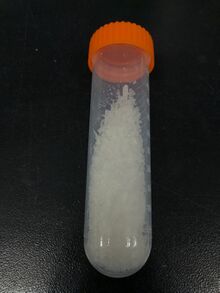Chemistry:Europium(III) nitrate
From HandWiki

| |
| Names | |
|---|---|
| IUPAC name
Europium trinitrate
| |
| Identifiers | |
| |
3D model (JSmol)
|
|
| ChemSpider | |
PubChem CID
|
|
| |
| |
| Properties | |
| Eu(NO3)3 | |
| Molar mass | 337.985 g/mol 446.081 g/mol (hexahydrate) |
| Melting point | decomposes |
| Soluble | |
| Hazards | |
| GHS pictograms |  
|
| GHS Signal word | Warning |
| H272, H315, H319, H335 | |
| P210, P220, P221, P261, P264, P271, P280, P302+352, P304+340, P305+351+338, P312, P321, P332+313, P337+313, P362, P370+378, P403+233, P405, P501 | |
| Related compounds | |
Other anions
|
Europium(III) phosphate Europium(III) arsenate |
Other cations
|
Samarium(III) nitrate Gadolinium(III) nitrate |
Related compounds
|
Europium(II) nitrate Europium(III) oxide |
Except where otherwise noted, data are given for materials in their standard state (at 25 °C [77 °F], 100 kPa). | |
| Infobox references | |
Europium(III) nitrate is an inorganic compound with the formula Eu(NO3)3. Its hexahydrate is the most common form, which is a colorless hygroscopic crystal.
Preparation
Dissolving europium(III) oxide (Eu2O3) in dilute nitric acid produces europium(III) nitrate.[1]
- Eu2O3 + 6 HNO3 → 2 Eu(NO3)3 + 3 H2O
Complexes
Europium(III) nitrate reacts with some ligands to form complexes. It reacts with 1,3,5-trimesic acid, producing europium metal-organic framework, a coordination polymer, under hydrothermal conditions.[2]
References
- ↑ Odent, Guy; Charetteur, Elisabeth; Duperray, Marie H. Crystallization, radiocrystallographic characterization, and infrared absorption spectra of hexahydrates and pentahydrates of nitrates and lanthanides. Revue de Chimie Minerale, 1975. 12 (1): 17-23.
- ↑ Habimana, Fabien; Huo, Yanxia; Jiang, Sai; Ji, Shengfu. Synthesis of europium metal-organic framework (Eu-MOF) and its performance in adsorptive desulfurization. Adsorption, 2016. 22 (8): 1147-1155. DOI:10.1007/s10450-016-9838-1.
Salts and covalent derivatives of the nitrate ion
| HNO3 | He | ||||||||||||||||
| LiNO3 | Be(NO3)2 | B(NO3)−4 | C | NO−3, NH4NO3 |
O | FNO3 | Ne | ||||||||||
| NaNO3 | Mg(NO3)2 | Al(NO3)3 | Si | P | S | ClONO2 | Ar | ||||||||||
| KNO3 | Ca(NO3)2 | Sc(NO3)3 | Ti(NO3)4 | VO(NO3)3 | Cr(NO3)3 | Mn(NO3)2 | Fe(NO3)3, Fe(NO3)2 |
Co(NO3)2, Co(NO3)3 |
Ni(NO3)2 | Cu(NO3)2 | Zn(NO3)2 | Ga(NO3)3 | Ge | As | Se | Br | Kr |
| RbNO3 | Sr(NO3)2 | Y(NO3)3 | Zr(NO3)4 | Nb | Mo | Tc | Ru | Rh | Pd(NO3)2 | AgNO3 | Cd(NO3)2 | In | Sn | Sb(NO3)3 | Te | I | Xe(NO3)2 |
| CsNO3 | Ba(NO3)2 | Hf | Ta | W | Re | Os | Ir | Pt | Au | Hg2(NO3)2, Hg(NO3)2 |
Tl(NO3)3, TlNO3 |
Pb(NO3)2 | Bi(NO3)3 BiO(NO3) |
Po | At | Rn | |
| FrNO3 | Ra(NO3)2 | Rf | Db | Sg | Bh | Hs | Mt | Ds | Rg | Cn | Nh | Fl | Mc | Lv | Ts | Og | |
| ↓ | |||||||||||||||||
| La(NO3)3 | Ce(NO3)3, Ce(NO3)4 |
Pr | Nd(NO3)3 | Pm | Sm | Eu(NO3)3 | Gd(NO3)3 | Tb(NO3)3 | Dy | Ho | Er | Tm | Yb | Lu | |||
| Ac(NO3)3 | Th(NO3)4 | Pa | UO2(NO3)2 | Np | Pu | Am | Cm | Bk | Cf | Es | Fm | Md | No | Lr | |||
category:nitrates


